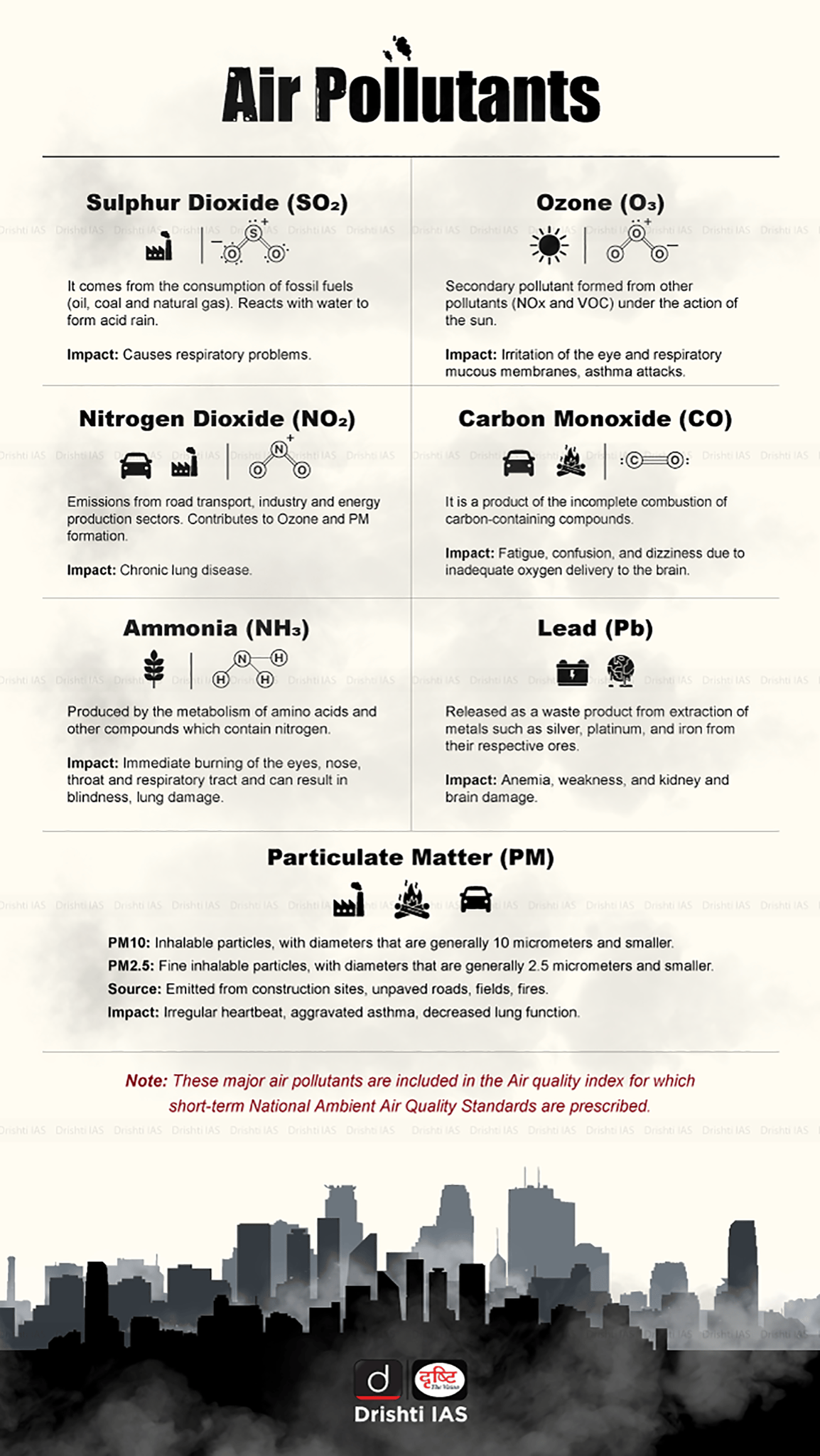Ground-Level Ozone Pollution in India | 13 Aug 2024
Why in News?
A recent study by the Centre for Science and Environment (CSE) has brought attention to the alarming levels of ground-level ozone (O3) in major cities across India.
- The findings raise serious concerns about public health, particularly for vulnerable populations such as those with respiratory issues.
What are the Key Findings of the Study?
- High Ozone Exceedance in Major Cities: Delhi-NCR recorded 176 days of ground-level ozone exceedance between 1st January and 18th July 2023, leading the list. Mumbai and Pune followed with 138 days each, while Jaipur had 126 days.
- Contrary to expectations, ozone levels remained high after sunset in several cities, with Mumbai logging 171 nights of exceedance, and Delhi-NCR 161 nights.
- Compared to last year, seven out of ten cities saw increased ozone exceedances, with Ahmedabad's rising by 4,000%, followed by Pune, with a 500% rise and Jaipur, with a 152% rise.
- Standards and Measurement Issues: The 8-hourly standard for ozone is set at 100 µg/m³. The one-hour standard is 180 µg/m³.
- The study highlights that the Central Pollution Control Board caps data at 200 µg/m³, making it difficult to fully assess the severity of exceedances.
- Health Risks: Exposure to ground-level ozone can cause respiratory problems, including chest pain, coughing, bronchitis, emphysema, and asthma, and can also inflame and damage the lining of the lungs, leading to long-term health issues.
- Green Areas Worst Affected: High-end, green neighbourhoods were found to be hotspots for ground-level ozone, challenging the assumption that these areas are safer in terms of air quality.
- Ozone tends to accumulate in cleaner areas where fewer gaseous pollutants are available to react with it.
- Inverse Spatial Distribution: The study found that the spatial distribution of ozone is inversely related to nitrogen dioxide (NO2) and particulate matter (PM2.5). While ozone is created in polluted areas, it tends to drift and accumulate in areas with less NO2, making these areas more vulnerable to higher ozone concentrations.
What is Ground-Level Ozone?
- About: Ground-level ozone, or tropospheric ozone, is a secondary pollutant formed when nitrogen oxides (NOx) and volatile organic compounds (VOCs) from vehicles, industries, and power plants react in the presence of sunlight, with levels rising especially during summer. It is a colourless gas forming just above the Earth’s surface.
- Unlike the beneficial ozone layer in the stratosphere, which protects the Earth from harmful ultraviolet (UV) radiation, ground-level ozone is a harmful air pollutant it is often referred to as "bad ozone".
- Rising temperatures, especially during heatwaves, worsen ground-level ozone formation, leading to dangerous air quality in cities like New Delhi when ozone levels exceed permissible limits.
- Impact: A significant increase in ozone-attributable deaths has been observed globally, with South Asia, including India, showing the highest rise. Projections suggest that by 2050, more than a million deaths in India could be linked to ozone exposure if emissions of its precursor gases are not adequately controlled.
- Ground-level ozone is detrimental to crop health, reducing yields and seed quality. Essential crops like wheat and rice, which are staples in India, are particularly vulnerable to ozone pollution, threatening food security.
- Concerns for India: India is home to 10 of the world's 15 most polluted cities, with air quality far exceeding World Health Organization (WHO) guidelines.
-
The poor air quality, rising temperatures, and frequent heat waves make India vulnerable to the harmful effects of ground-level ozone.
- The country's growing and ageing population is increasingly at risk from the health impacts of ozone pollution, and the public health burden is likely to increase as more people are exposed to this pollutant.
-
- Challenge in Reducing Ground-Level Ozone: Unlike other air pollutants, ground-level ozone is part of a cyclical chemical reaction. Reducing precursor gases (NOx and VOCs) does not necessarily reduce ozone levels, and if conditions are not carefully managed, ozone can linger in the atmosphere, leading to prolonged exposure.
- Expanding air quality monitoring and implementing alerts like Delhi can help mitigate ozone pollution by informing the public and industries when to take preventive actions.
Initiatives to Control Air Pollution
UPSC Civil Services Examination Previous Year Question (PYQ)
Prelims
Q. Consider the following: (2019)
- Carbon monoxide
- Methane
- Ozone
- Sulphur dioxide
Which of the above are released into atmosphere due to the burning of crop/biomass residue?
(a) 1 and 2 only
(b) 2, 3 and 4 only
(c) 1 and 4 only
(d) 1, 2, 3 and 4
Ans: (d)

